Integrating Remote Sensing and Meteorological Data to Predict Wheat Stripe Rust
Abstract
:1. Introduction
2. Materials and Methods
2.1. Field Survey and Data Collection
2.1.1. Study Site
2.1.2. Wheat Stripe Rust Survey Data Acquisition
2.1.3. Remote Sensing Data Acquisition and Preprocessing
2.1.4. Meteorological Data Acquisition and Preprocessing
2.2. Construction of the Prediction Model for Wheat Stripe Rust
2.2.1. Growth Conditions Extraction
Vegetation Indices Extraction
The Wheat-Jointing Date Estimation
- i.
- S-G filtering was used to smooth the NDVI time-series images from 2018 to 2020. Then, the smoothed NDVI time-series curves were fitted using HANTS.
- ii.
- Based on the growth characteristics of wheat, regreening is the stage of wheat growth recovery, corresponding to the date when the NDVI time-series curve reaches its minimum (i.e., the regreening date corresponding to the square in Figure 3), and jointing is the stage of rapid wheat growth, corresponding to the date when the first-order derivatives of the NDVI time-series curve reach maximum (i.e., the jointing date corresponding to the circle in Figure 3) [45,46,47,48]. The fitted NDVI curves were used to extract the regreening and jointing dates for 2018–2020 and the regreening date for 2021.
- iii.
- The calculated average cumulative temperature from 2018 to 2020 from the regreening date to the jointing date was used as a threshold to estimate the wheat-jointing date in 2021 based on meteorological data.
Phenological Information-Based Vegetation Indices Extraction
2.2.2. Habitat Conditions Extraction
2.2.3. Wheat Stripe Rust Prediction Model Construction
3. Results and Discussion
3.1. Vegetation Indices for Wheat Stripe Rust
3.2. Meteorological Features for Wheat Stripe Rust
3.3. Evaluation of Prediction Model for Wheat Stripe Rust
3.4. Future Work
4. Conclusions
Author Contributions
Funding
Data Availability Statement
Conflicts of Interest
References
- Han, J.; Zhang, Z.; Cao, J.; Luo, Y.; Zhang, L.; Li, Z.; Zhang, J. Prediction of Winter Wheat Yield Based on Multi-Source Data and Machine Learning in China. Remote Sens. 2020, 12, 236. [Google Scholar] [CrossRef] [Green Version]
- Chen, X. Pathogens which threaten food security: Puccinia striiformis, the wheat stripe rust pathogen. Food Secur. 2020, 12, 239–251. [Google Scholar] [CrossRef]
- Chen, X. Epidemiology and control of stripe rust [Puccinia striiformis f. sp. tritici] on wheat. Can. J. Plant Pathol. 2005, 27, 314–337. [Google Scholar] [CrossRef]
- Carmona, M.; Sautua, F.; Pérez-Hérnandez, O.; Reis, E.M. Role of fungicide applications on the integrated management of wheat stripe rust. Front Plant Sci. 2020, 11, 733. [Google Scholar] [CrossRef]
- Zheng, Q.; Ye, H.; Huang, W.; Dong, Y.; Jiang, H.; Wang, C.; Li, D.; Wang, L.; Chen, S. Integrating Spectral Information and Meteorological Data to Monitor Wheat Yellow Rust at a Regional Scale: A Case Study. Remote Sens. 2021, 13, 278. [Google Scholar] [CrossRef]
- Sankaran, S.; Mishra, A.; Ehsani, R.; Davis, C. A review of advanced techniques for detecting plant diseases. Comput. Electron. Agric. 2010, 72, 1–13. [Google Scholar] [CrossRef]
- Berger, R. Description and application of some general models for plant disease epidemics. Plant Dis. Epidemiol. 1989, 2, 125–149. [Google Scholar]
- Katsantonis, D.; Kadoglidou, K.; Dramalis, C.; Puigdollers, P. Rice blast forecasting models and their practical value: A review. Phytopathol. Mediterr. 2017, 56, 187–216. [Google Scholar]
- Ali, S.; Rodriguez-Algaba, J.; Thach, T.; Sorensen, C.K.; Hansen, J.G.; Lassen, P.; Nazari, K.; Hodson, D.P.; Justesen, A.F.; Hovmoller, M.S. Yellow Rust Epidemics Worldwide Were Caused by Pathogen Races from Divergent Genetic Lineages. Front. Plant Sci. 2017, 8, 1057. [Google Scholar] [CrossRef] [Green Version]
- Yuan, L.; Zhang, J.; Shi, Y.; Nie, C.; Wei, L.; Wang, J. Damage Mapping of Powdery Mildew in Winter Wheat with High-Resolution Satellite Image. Remote Sens. 2014, 6, 3611–3623. [Google Scholar] [CrossRef] [Green Version]
- Yudarwati, R.; Hongo, C.; Sigit, G.; Barus, B.; Utoyo, B. Bacterial Leaf Blight Detection in Rice Crops Using Ground-Based Spectroradiometer Data and Multi-temporal Satellites Images. J. Agric. Sci. 2020, 12, 38. [Google Scholar] [CrossRef]
- Zhang, J.; Huang, Y.; Pu, R.; Gonzalez-Moreno, P.; Yuan, L.; Wu, K.; Huang, W. Monitoring plant diseases and pests through remote sensing technology: A review. Comput. Electron. Agric. 2019, 165, 104943. [Google Scholar] [CrossRef]
- Dutta, S.; Singh, S.K.; Khullar, M. A Case Study on Forewarning of Yellow Rust Affected Areas on Wheat Crop Using Satellite Data. J. Indian Soc. Remote Sens. 2014, 42, 335–342. [Google Scholar] [CrossRef]
- Dong, Y.; Xu, F.; Liu, L.; Du, X.; Ren, B.; Guo, A.; Geng, Y.; Ruan, C.; Ye, H.; Huang, W. Automatic System for Crop Pest and Disease Dynamic Monitoring and Early Forecasting. IEEE J. Sel. Top. Appl. Earth Obs. Remote Sens. 2020, 13, 4410–4418. [Google Scholar] [CrossRef]
- Ruan, C.; Dong, Y.; Huang, W.; Huang, L.; Ye, H.; Ma, H.; Guo, A.; Ren, Y. Prediction of Wheat Stripe Rust Occurrence with Time Series Sentinel-2 Images. Agriculture. 2021, 11, 1079. [Google Scholar] [CrossRef]
- Oerke, E.-C. Remote sensing of diseases. Annu. Rev. Phytopathol. 2020, 58, 225–252. [Google Scholar] [CrossRef]
- Zhang, J.; Pu, R.; Yuan, L.; Huang, W.; Nie, C.; Yang, G. Integrating remotely sensed and meteorological observations to forecast wheat powdery mildew at a regional scale. IEEE J. Sel. Top. Appl. Earth Obs. Remote Sens. 2014, 7, 4328–4339. [Google Scholar] [CrossRef]
- Xiao, Y.; Dong, Y.; Huang, W.; Liu, L.; Ma, H.; Ye, H.; Wang, K. Dynamic Remote Sensing Prediction for Wheat Fusarium Head Blight by Combining Host and Habitat Conditions. Remote Sens. 2020, 12, 3046. [Google Scholar] [CrossRef]
- Yuan, L.; Bao, Z.; Zhang, H.; Zhang, Y.; Liang, X. Habitat monitoring to evaluate crop disease and pest distributions based on multi-source satellite remote sensing imagery. Optik 2017, 145, 66–73. [Google Scholar] [CrossRef]
- Tao, F.; Zhang, S.; Zhang, Z. Spatiotemporal changes of wheat phenology in China under the effects of temperature, day length and cultivar thermal characteristics. Eur. J. Agron. 2012, 43, 201–212. [Google Scholar] [CrossRef]
- Ahmed, M.; Farooq, S. Growth and physiological responses of wheat cultivars under various planting windows. J. Anim. Plant Sci. 2013, 23, 1407–1414. [Google Scholar]
- Ashraf, M.A.; Ashraf, M. Growth stage-based modulation in physiological and biochemical attributes of two genetically diverse wheat (Triticum aestivum L.) cultivars grown in salinized hydroponic culture. Environ. Sci Pollut R. 2016, 23, 6227–6243. [Google Scholar] [CrossRef]
- Zhang, B.; Liu, X.; Liu, M.; Meng, Y. Detection of Rice Phenological Variations under Heavy Metal Stress by Means of Blended Landsat and MODIS Image Time Series. Remote Sens. 2019, 11, 13. [Google Scholar] [CrossRef] [Green Version]
- Zheng, X.; Li, S. Analysis of soil environmental factors which affect protein content of winter wheat. Acta Bot. Boreali-Occident. Sin. 2003, 23, 2132–2136. [Google Scholar]
- Chen, W.; Kang, Z.; Ma, Z.; Xu, S.; Jin, S.; Jiang, Y. Integrated management of wheat stripe rust caused by Puccinia striiformis f. sp. tritici in China. Sci. Agric. Sin. 2013, 46, 4254–4262. [Google Scholar]
- Xie, Y.; Wang, P.; Sun, H.; Zhang, S.; Li, L. Assimilation of leaf area index and surface soil moisture with the CERES-wheat model for winter wheat yield estimation using a particle filter algorithm. IEEE J. Sel. Top. Appl. Earth Obs. Remote Sens. 2016, 10, 1303–1316. [Google Scholar] [CrossRef]
- Dengke, L.; Zhao, W.; Feizhou, X. Occurrence regularity and meteorological influencing factors of wheat stripe rust in Shaanxi province. J. Catastrophol. 2019, 34, 59–65. [Google Scholar]
- Zheng, Q.; Huang, W.; Cui, X.; Yue, S.; Liu, L. New Spectral Index for Detecting Wheat Yellow Rust Using Sentinel-2 Multispectral Imagery. Sensors 2018, 18, 868. [Google Scholar] [CrossRef] [Green Version]
- Korhonen, L.; Packalen, P.; Rautiainen, M. Comparison of Sentinel-2 and Landsat 8 in the estimation of boreal forest canopy cover and leaf area index. Remote Sens. Environ. 2017, 195, 259–274. [Google Scholar] [CrossRef]
- Li, Z.; Yang, P.; Zhou, Q.; Wang, Y.; Wu, W.; Zhang, L.; Zhang, X. Research on spatiotemporal pattern of crop phenological characteristics and cropping system in North China based on NDVI time series data. Acta Ecol. Sin. 2009, 29, 6216–6226. [Google Scholar]
- Wang, L.; Liu, J.; Yang, F.; Fu, C.; Teng, F.; Gao, J. Early recognition of winter wheat area based on GF-1 satellite. Trans. Chin. Soc. Agric. Eng. 2015, 31, 194–201. [Google Scholar]
- Salarux, C.; Kaewplang, S. Estimation of Algal Bloom Biomass Using UAV-Based Remote Sensing with NDVI and GRVI. Mahasarakham Int. J. Eng. Technol. 2020, 6, 1–6. [Google Scholar]
- Mutanga, O.; Adam, E.; Cho, M.A. High density biomass estimation for wetland vegetation using WorldView-2 imagery and random forest regression algorithm. Int. J. Appl. Earth Obs. Geoinf. 2012, 18, 399–406. [Google Scholar] [CrossRef]
- Kanke, Y.; Raun, W.; Solie, J.; Stone, M.; Taylor, R. Red edge as a potential index for detecting differences in plant nitrogen status in winter wheat. J. Plant Nutr. 2012, 35, 1526–1541. [Google Scholar] [CrossRef]
- Benincasa, P.; Antognelli, S.; Brunetti, L.; Fabbri, C.A.; Natale, A.; Sartoretti, V.; Modeo, G.; Guiducci, M.; Tei, F.; Vizzari, M. Reliability of NDVI derived by high resolution satellite and UAV compared to in-field methods for the evaluation of early crop N status and grain yield in wheat. Exp. Agric. 2018, 54, 604–622. [Google Scholar] [CrossRef]
- Papastamati, K.; Van Den Bosch, F.; Welham, S.; Fitt, B.D.; Evans, N.; Steed, J. Modelling the daily progress of light leaf spot epidemics on winter oilseed rape (Brassica napus), in relation to Pyrenopeziza brassicae inoculum concentrations and weather factors. Ecol. Model. 2002, 148, 169–189. [Google Scholar] [CrossRef]
- Haboudane, D.; Miller, J.R.; Pattey, E.; Zarco-Tejada, P.J.; Strachan, I.B. Hyperspectral vegetation indices and novel algorithms for predicting green LAI of crop canopies: Modeling and validation in the context of precision agriculture. Remote Sens. Environ. 2004, 90, 337–352. [Google Scholar] [CrossRef]
- Rouse, J.W.; Haas, R.W.; Schell, J.A.; Deering, D.W.; Harlan, J.C. Monitoring the Vernal Advancement and Retrogradation (Green Wave Effect) of Natural Vegetation; NASA/GSFC Type III, Final Report; Remote Sensing Center, Texas A & M University: Greenbelt, MD, USA, 1974. [Google Scholar]
- Gitelson, A.; Merzlyak, M.N. Quantitative estimation of chlorophyll-a using reflectance spectra: Experiments with autumn chestnut and maple leaves. J. Photochem. Photobiol. B Biol. 1994, 22, 247–252. [Google Scholar] [CrossRef]
- Merzlyak, M.N.; Gitelson, A.A.; Chivkunova, O.B.; Rakitin, V.Y. Non-destructive optical detection of pigment changes during leaf senescence and fruit ripening. Physiol. Plant. 1999, 106, 135–141. [Google Scholar] [CrossRef] [Green Version]
- Broge, N.H.; Leblanc, E. Comparing prediction power and stability of broadband and hyperspectral vegetation indices for estimation of green leaf area index and canopy chlorophyll density. Remote Sens. Environ. 2001, 76, 156–172. [Google Scholar] [CrossRef]
- Galvao, L.S.; Formaggio, A.R.; Tisot, D.A. Discrimination of sugarcane varieties in Southeastern Brazil with EO-1 Hyperion data. Remote Sens. Environ. 2005, 94, 523–534. [Google Scholar] [CrossRef]
- Zhou, J.; Jia, L.; Menenti, M. Reconstruction of global MODIS NDVI time series: Performance of Harmonic ANalysis of Time Series (HANTS). Remote Sens. Environ. 2015, 163, 217–228. [Google Scholar] [CrossRef]
- Song, Y.; Wang, J. Mapping Winter Wheat Planting Area and Monitoring Its Phenology Using Sentinel-1 Backscatter Time Series. Remote Sens. 2019, 11, 449. [Google Scholar] [CrossRef] [Green Version]
- Huang, J.; Zhao, J.; Wang, X.; Xie, Z.; Zhuo, W.; Huang, R. Extraction Method of Growth Stages of Winter Wheat Based on Accumulated Temperature and Remote Sensing Data. Nongye Jixie Xuebao. Trans. Chin. Soc. Agric. Mach. 2019, 50, 169–176. [Google Scholar]
- Yang, Y.; Zhan, Y.; Tian, Q.; Gu, X.; Yu, T.; Wang, L. Crop classification based on GF-1/WFV NDVI time series. Trans. Chin. Soc. Agric. Eng. 2015, 31, 155–161. [Google Scholar]
- Yang, Y.; Ren, W.; Tao, B.; Ji, L.; Liang, L.; Ruane, A.C.; Fisher, J.B.; Liu, J.; Sama, M.; Li, Z. Characterizing spatiotemporal patterns of crop phenology across North America during 2000–2016 using satellite imagery and agricultural survey data. ISPRS J. Photogramm. Remote Sens. 2020, 170, 156–173. [Google Scholar] [CrossRef]
- Pan, Z.; Huang, J.; Zhou, Q.; Wang, L.; Cheng, Y.; Zhang, H.; Blackburn, G.A.; Yan, J.; Liu, J. Mapping crop phenology using NDVI time-series derived from HJ-1 A/B data. Int. J. Appl. Earth Obs. Geoinf. 2015, 34, 188–197. [Google Scholar] [CrossRef] [Green Version]
- Naseri, B.; Marefat, A. Wheat stripe rust epidemics in interaction with climate, genotype and planting date. Eur. J. Plant Pathol. 2019, 154, 1077–1089. [Google Scholar] [CrossRef]
- Xu, X.; Ma, L.; Hu, X. Overwintering of wheat stripe rust under field conditions in the northwestern regions of China. Plant Dis. 2019, 103, 638–644. [Google Scholar] [CrossRef] [PubMed] [Green Version]
- Zeng, S.-M.; Luo, Y. Long-distance spread and interregional epidemics of wheat stripe rust in China. Plant Dis. 2006, 90, 980–988. [Google Scholar] [CrossRef] [PubMed] [Green Version]
- Shen, Q.; Wang, K. Research status and future directions on epidemiology of wheat stripe rust in China. Acta Phytophylacica Sinica. 1962, 1, 393–402. [Google Scholar]
- Yang, X.; Nie, C.; Zhang, J.; Feng, H.; Yang, G. A Bayesian Network Model for Yellow Rust Forecasting in Winter Wheat. In International Conference on Computer and Computing Technologies in Agriculture (CCTA); Springer: Berlin/Heidelberg, Germany, 2017; Volume 545, pp. 65–75. [Google Scholar]
- Prank, M.; Kenaley, S.C.; Bergstrom, G.C.; Acevedo, M.; Mahowald, N.M. Climate change impacts the spread potential of wheat stem rust, a significant crop disease. Environ. Res. Lett. 2019, 14, 124053. [Google Scholar] [CrossRef] [Green Version]
- Belgiu, M.; Drăguţ, L. Random forest in remote sensing: A review of applications and future directions. ISPRS J. Photogramm. Remote Sens. 2016, 114, 24–31. [Google Scholar] [CrossRef]
- Du, X.; Li, Q.; Shang, J.; Liu, J.; Qian, B.; Jing, Q.; Dong, T.; Fan, D.; Wang, H.; Zhao, L. Detecting advanced stages of winter wheat yellow rust and aphid infection using RapidEye data in North China Plain. GISci. Remote Sens. 2019, 56, 1093–1113. [Google Scholar] [CrossRef]
- Magidi, J.; Nhamo, L.; Mpandeli, S.; Mabhaudhi, T. Application of the random forest classifier to map irrigated areas using google earth engine. Remote Sens. 2021, 13, 876. [Google Scholar] [CrossRef]
- Breiman, L. Random forests. Mach. Learn. 2001, 45, 5–32. [Google Scholar] [CrossRef] [Green Version]
- Brito, J.A.; McNeill, F.E.; Webber, C.E.; Chettle, D.R. Grid search: An innovative method for the estimation of the rates of lead exchange between body compartments. J. Environ. Monit. 2005, 7, 241–247. [Google Scholar] [CrossRef]
- Vapnik, V. The Nature of Statistical Learning Theory; Springer Science & Business Media: Berlin/Heidelberg, Germany, 2013. [Google Scholar]
- Pan, X.; Xu, Y. A safe feature elimination rule for L1-regularized logistic regression. IEEE Trans. Pattern Anal. Mach. Intell. 2021. [Google Scholar] [CrossRef] [PubMed]
- Congalton, R.G.; Mead, R.A. A quantitative method to test for consistency and correctness in photointerpretation. Photogramm. Eng. Remote Sens. 1983, 49, 69–74. [Google Scholar]
- Story, M.; Congalton, R.G. Accuracy assessment: A user’s perspective. Photogramm. Eng. Remote Sens. 1986, 52, 397–399. [Google Scholar]
- Rosenfield, G.H.; Fitzpatrick-Lins, K. A coefficient of agreement as a measure of thematic classification accuracy. Photogramm. Eng. Remote Sens. 1986, 52, 223–227. [Google Scholar]
- Refaeilzadeh, P.; Tang, L.; Liu, H. Cross-validation. Encycl. Database Syst. 2009, 5, 532–538. [Google Scholar]
- Chemura, A.; Mutanga, O.; Dube, T. Separability of coffee leaf rust infection levels with machine learning methods at Sentinel-2 MSI spectral resolutions. Precis. Agric. 2017, 18, 859–881. [Google Scholar] [CrossRef]
- Devadas, R.; Lamb, D.; Backhouse, D.; Simpfendorfer, S. Sequential application of hyperspectral indices for delineation of stripe rust infection and nitrogen deficiency in wheat. Precis. Agric. 2015, 16, 477–491. [Google Scholar] [CrossRef] [Green Version]
- Li, F.; Ren, J.; Wu, S.; Zhao, H.; Zhang, N. Comparison of Regional Winter Wheat Mapping Results from Different Similarity Measurement Indicators of NDVI Time Series and Their Optimized Thresholds. Remote Sens. 2021, 13, 1162. [Google Scholar] [CrossRef]
- Devadas, R.; Lamb, D.; Simpfendorfer, S.; Backhouse, D. Evaluating ten spectral vegetation indices for identifying rust infection in individual wheat leaves. Precis. Agric. 2009, 10, 459–470. [Google Scholar] [CrossRef]
- Li, D.; Quan, W.; Xie, F. Meteorological Forecast Model for Stripe Rust of Wheat in Shaanxi Province. J. Arid. Meteorol. 2017, 35, 128–133. [Google Scholar]
- Ma, H.; Huang, W.; Jing, Y. Wheat powdery mildew forecasting in filling stage based on remote sensing and meteorological data. Trans. Chin. Soc. Agric. Eng. 2016, 32, 165–172. [Google Scholar]
- Tien Bui, D.; Shahabi, H.; Shirzadi, A.; Chapi, K.; Hoang, N.-D.; Pham, B.T.; Bui, Q.-T.; Tran, C.-T.; Panahi, M.; Bin Ahmad, B.; et al. A Novel Integrated Approach of Relevance Vector Machine Optimized by Imperialist Competitive Algorithm for Spatial Modeling of Shallow Landslides. Remote Sens. 2018, 10, 1538. [Google Scholar] [CrossRef] [Green Version]
- Tang, C.; Huang, W.; Luo, J.; Liang, D.; Zhao, J.; Huang, L. Forecasting wheat aphid with remote sensing based on relevance vector machine. Trans. Chin. Soc. Agric. Eng. 2015, 31, 201–207. [Google Scholar]
- Li, L.; Jing, W.; Wang, H. Extracting the forest type from remote sensing images by random forest. IEEE Sens. J. 2020, 21, 17447–17454. [Google Scholar]
- Ghosh, S.; Dasgupta, A.; Swetapadma, A. A study on support vector machine based linear and non-linear pattern classification. In Proceedings of the International Conference on Intelligent Sustainable Systems, ICISS 2019, Palladam, India, 21–22 February 2019; Institute of Electrical and Electronics Engineers Inc.: Piscataway, NJ, USA, 2019; pp. 24–28. [Google Scholar]
- Chemura, A.; Mutanga, O.; Sibanda, M.; Chidoko, P. Machine learning prediction of coffee rust severity on leaves using spectroradiometer data. Trop. Plant Pathol. 2018, 43, 117–127. [Google Scholar] [CrossRef]
- Hu, X.; Cao, S.; Cornelius, A.; Xu, X. Predicting overwintering of wheat stripe rust in central and northwestern China. Plant Dis. 2020, 104, 44–51. [Google Scholar] [CrossRef] [PubMed]
- Sørensen, C. Infection Biology and Aggressiveness of Puccinia striiformis on Resistant and Susceptible Wheat. Ph.D. Thesis, University of Aarhus, Research Center Flakkebjerg, Aarhus, Denmark, 2012. [Google Scholar]
- Luo, C.; Ma, L.; Zhu, J.; Guo, Z.; Dong, K.; Dong, Y. Effects of nitrogen and intercropping on the occurrence of wheat powdery mildew and stripe rust and the relationship with crop yield. Front. Plant Sci. 2021, 12, 179. [Google Scholar] [CrossRef] [PubMed]
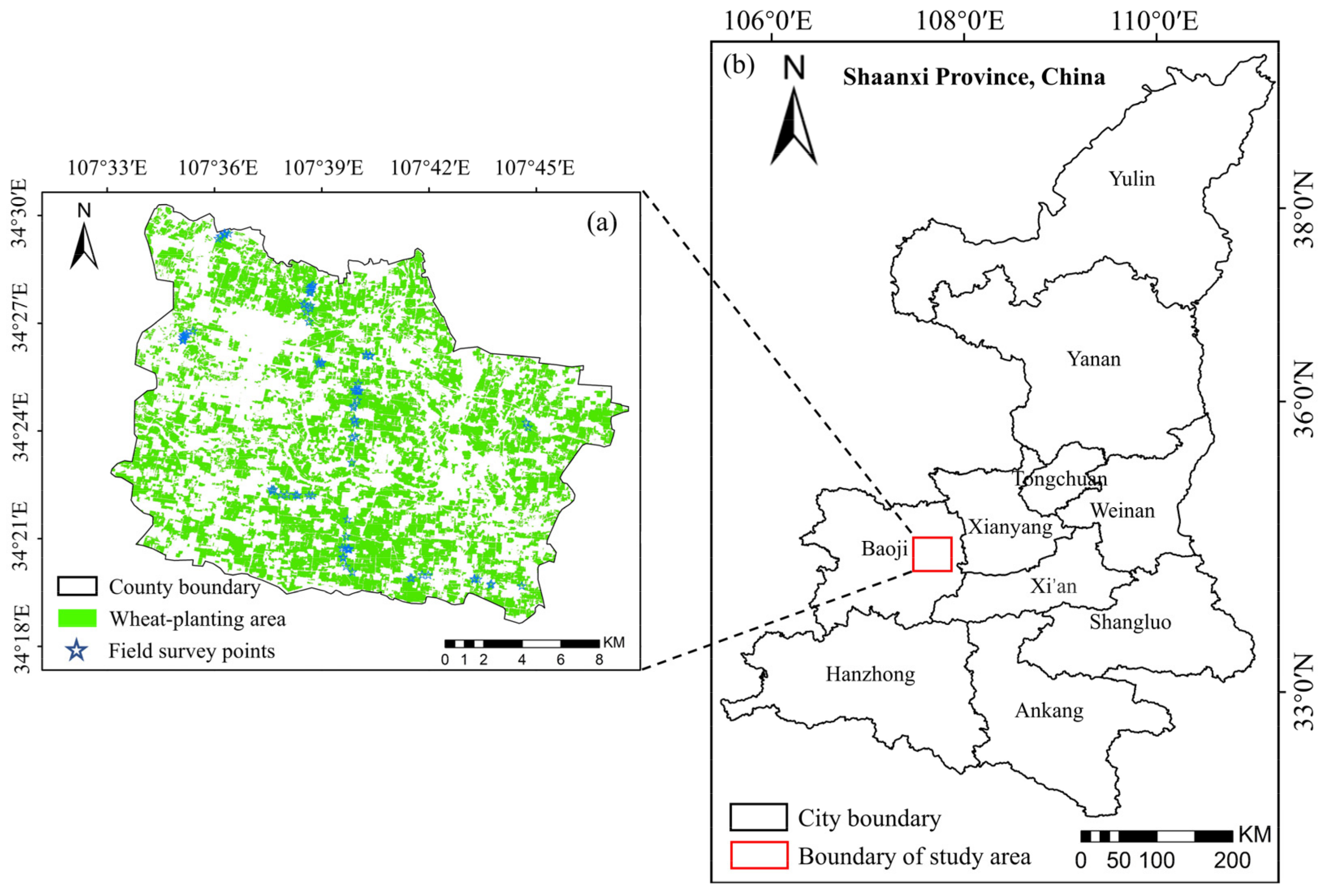
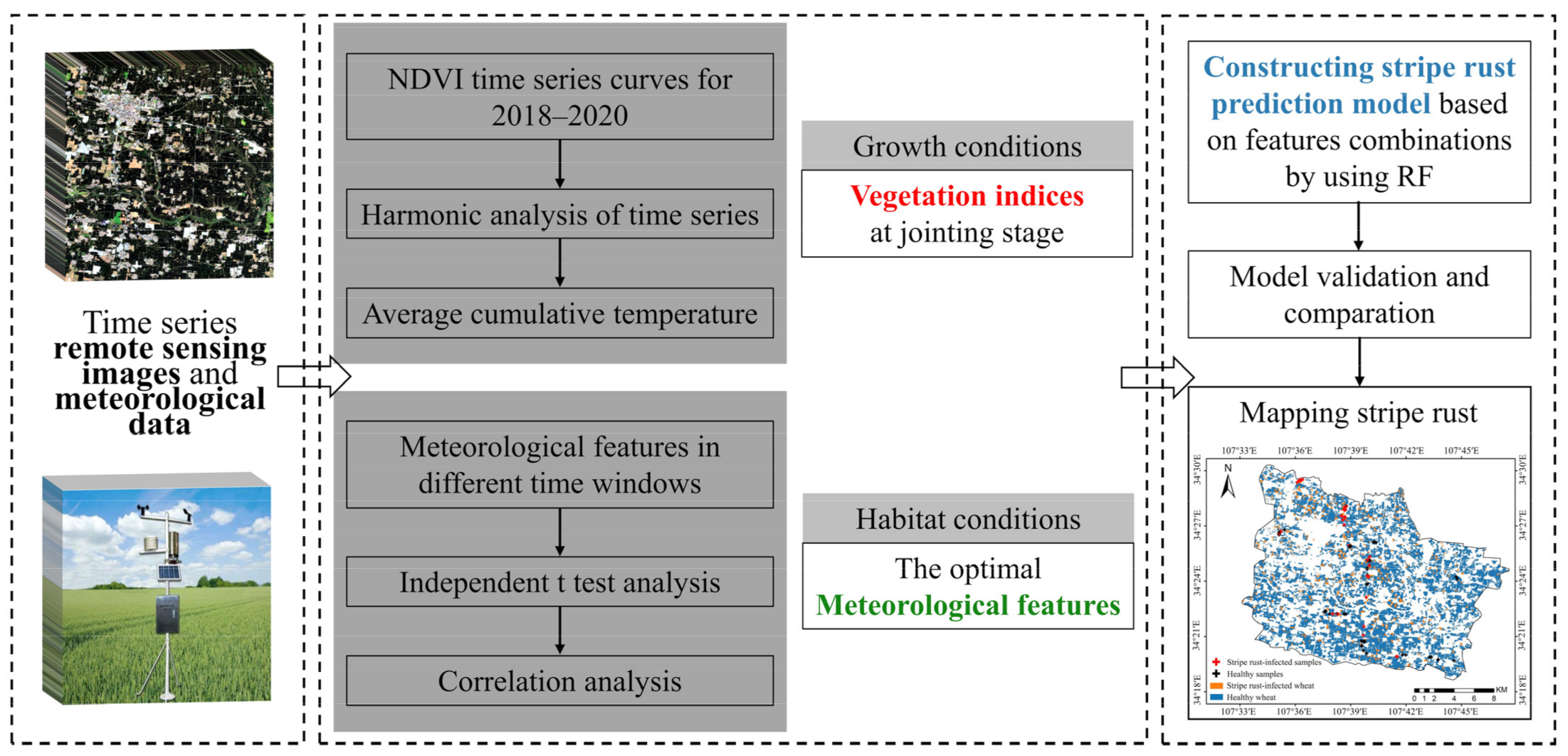
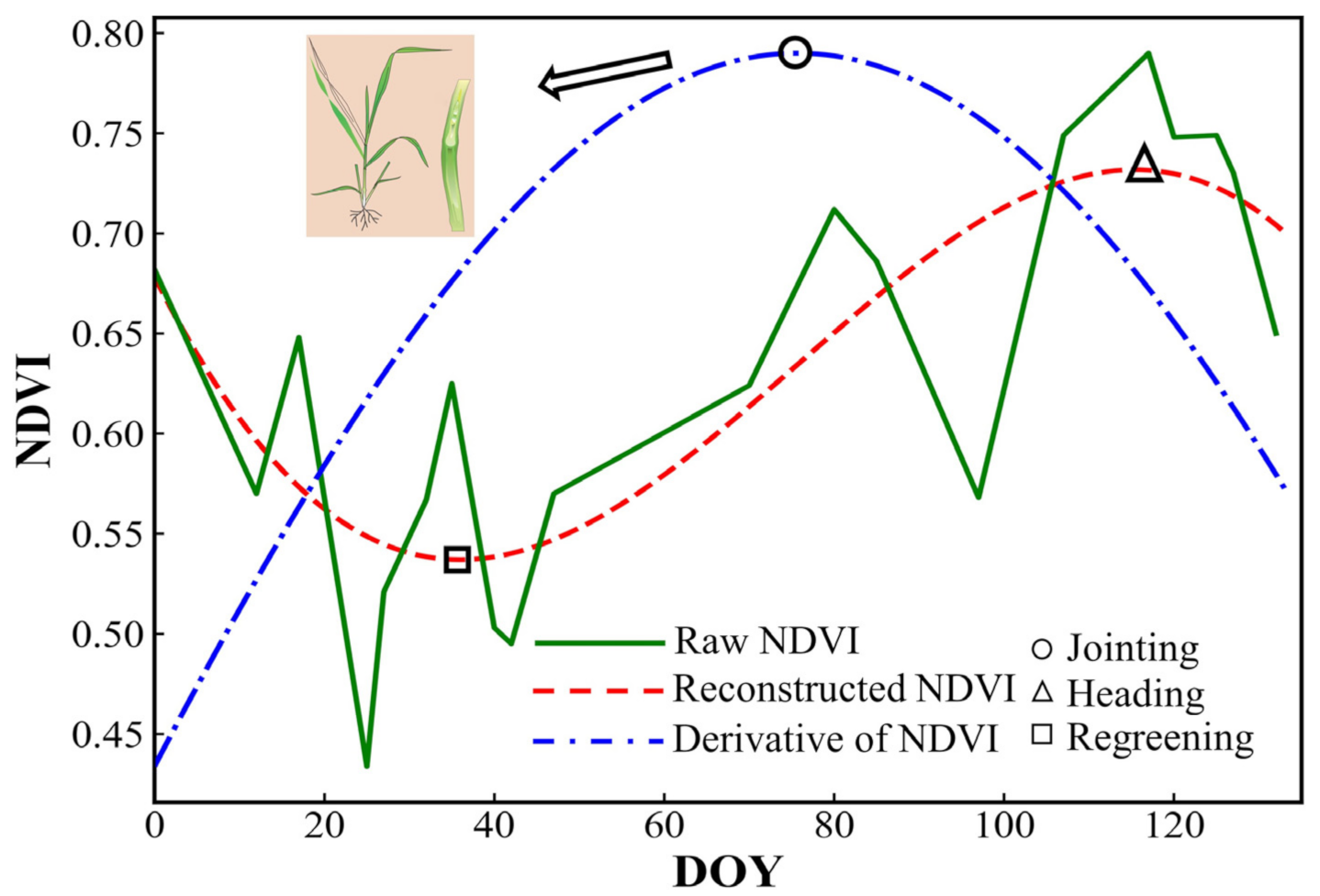
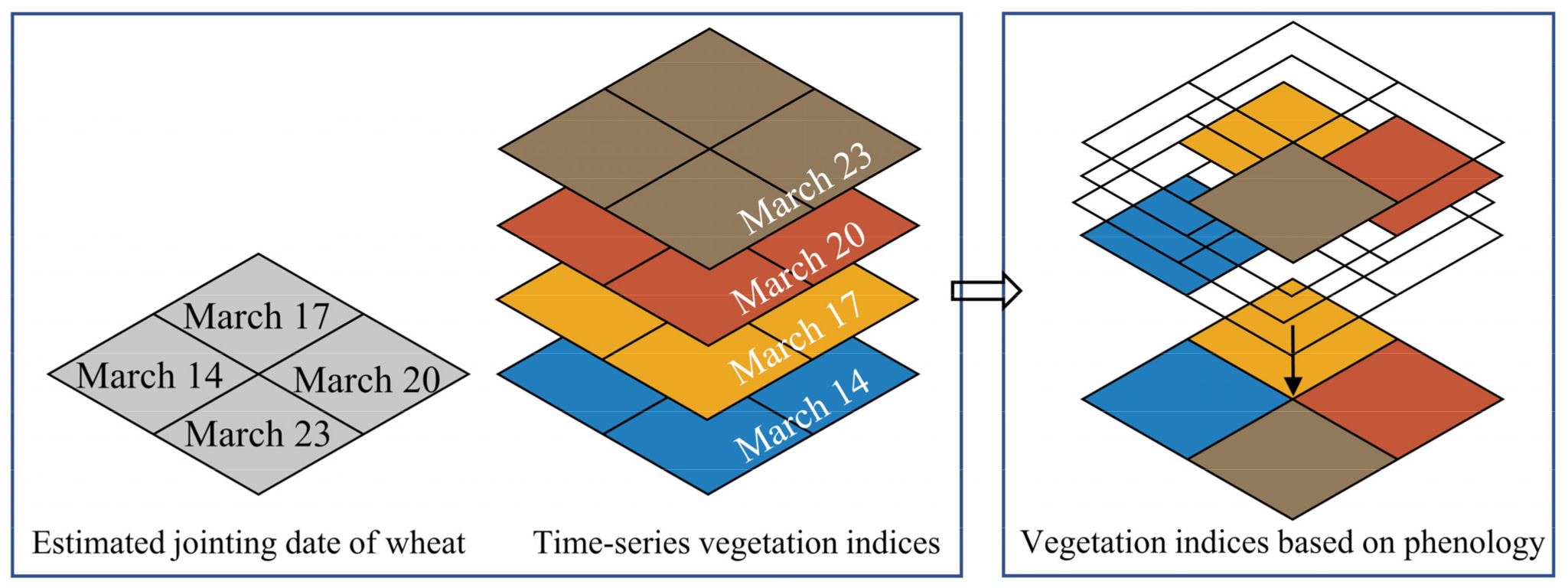
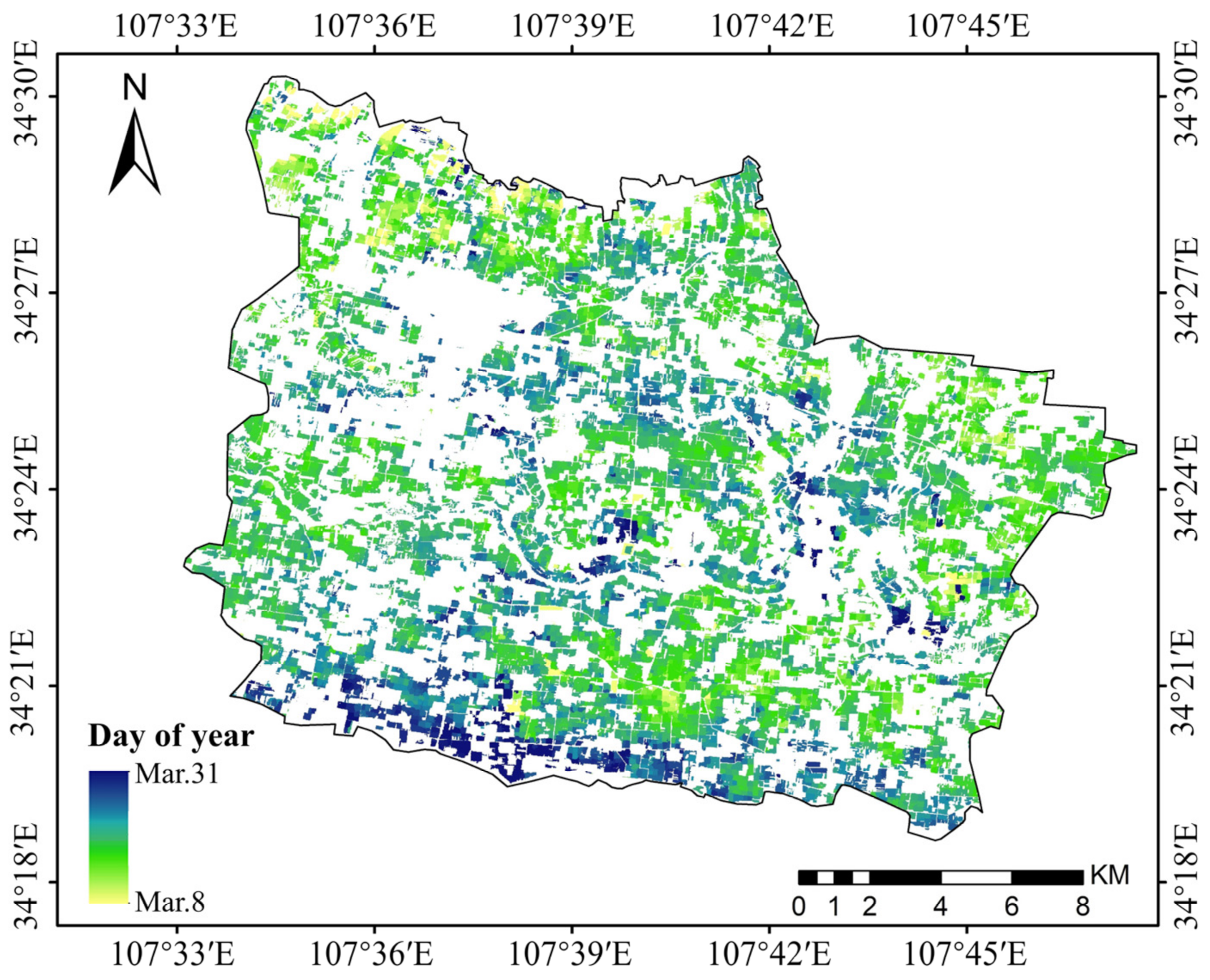

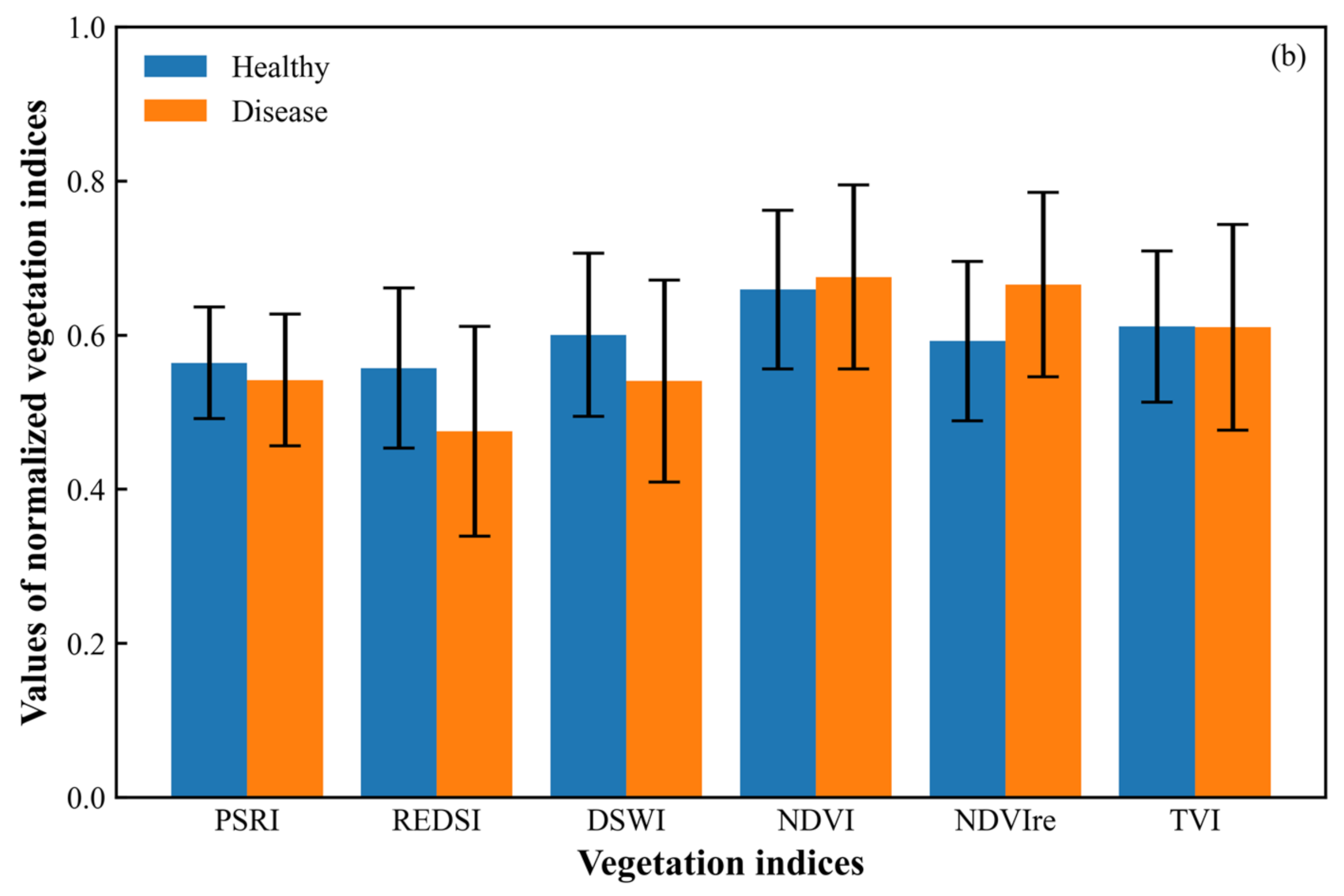
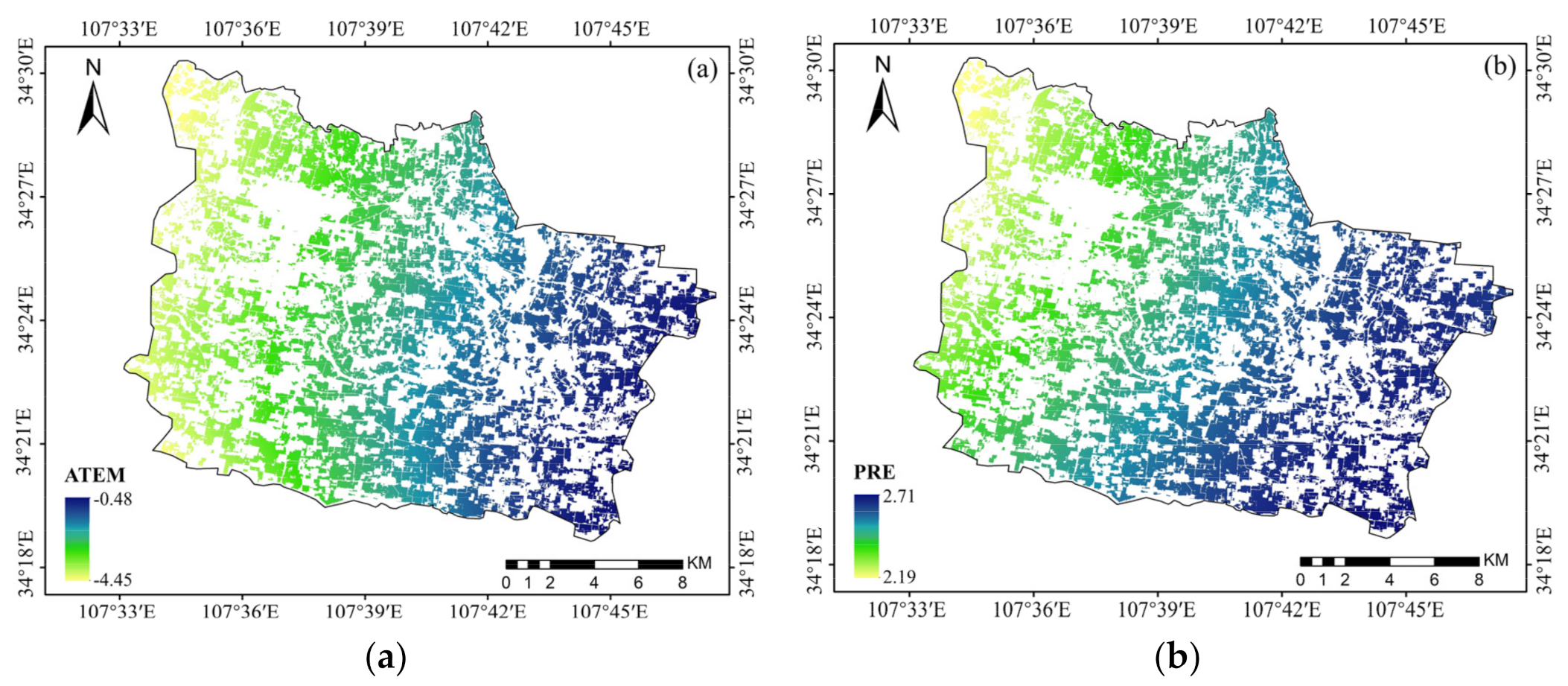
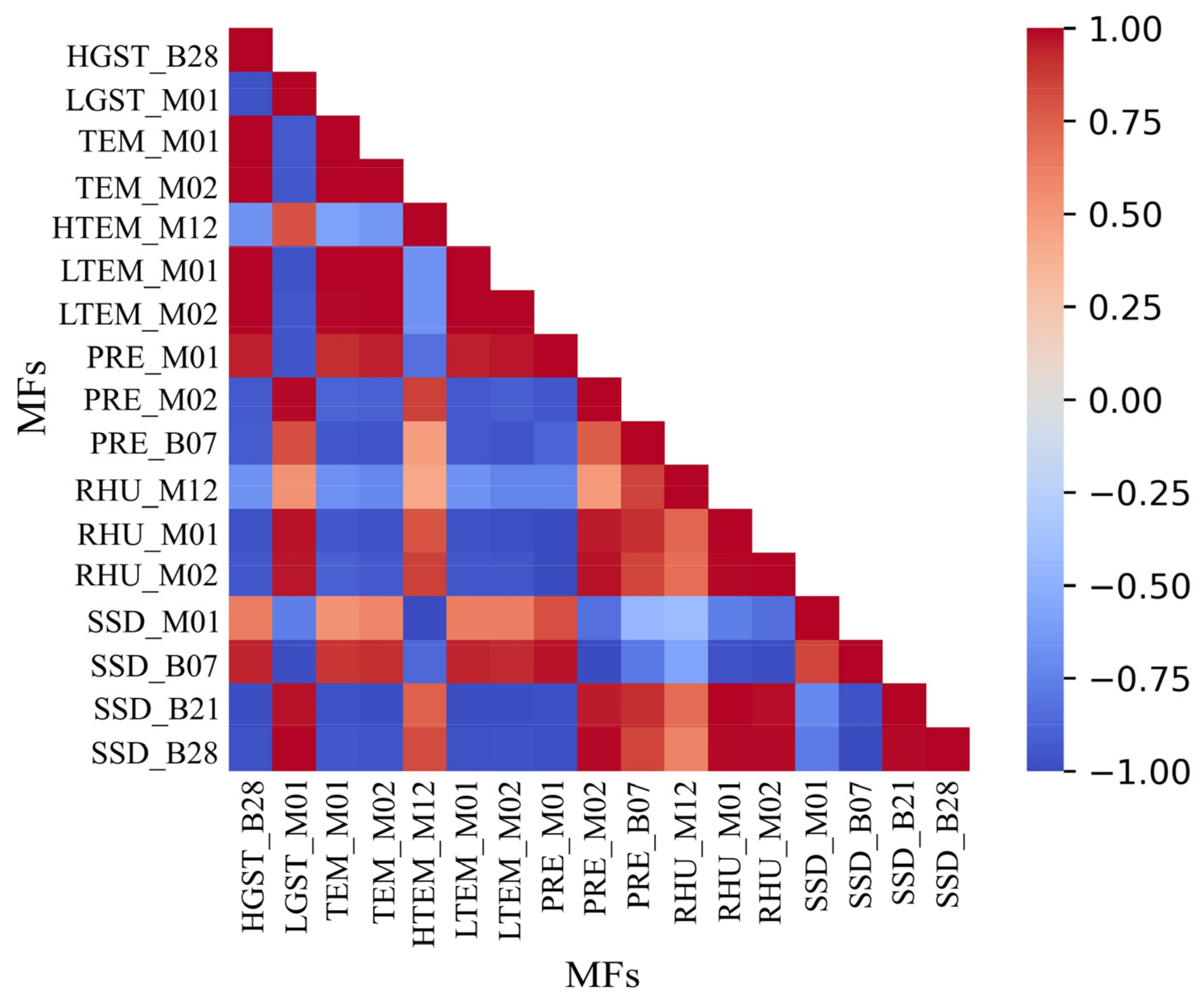
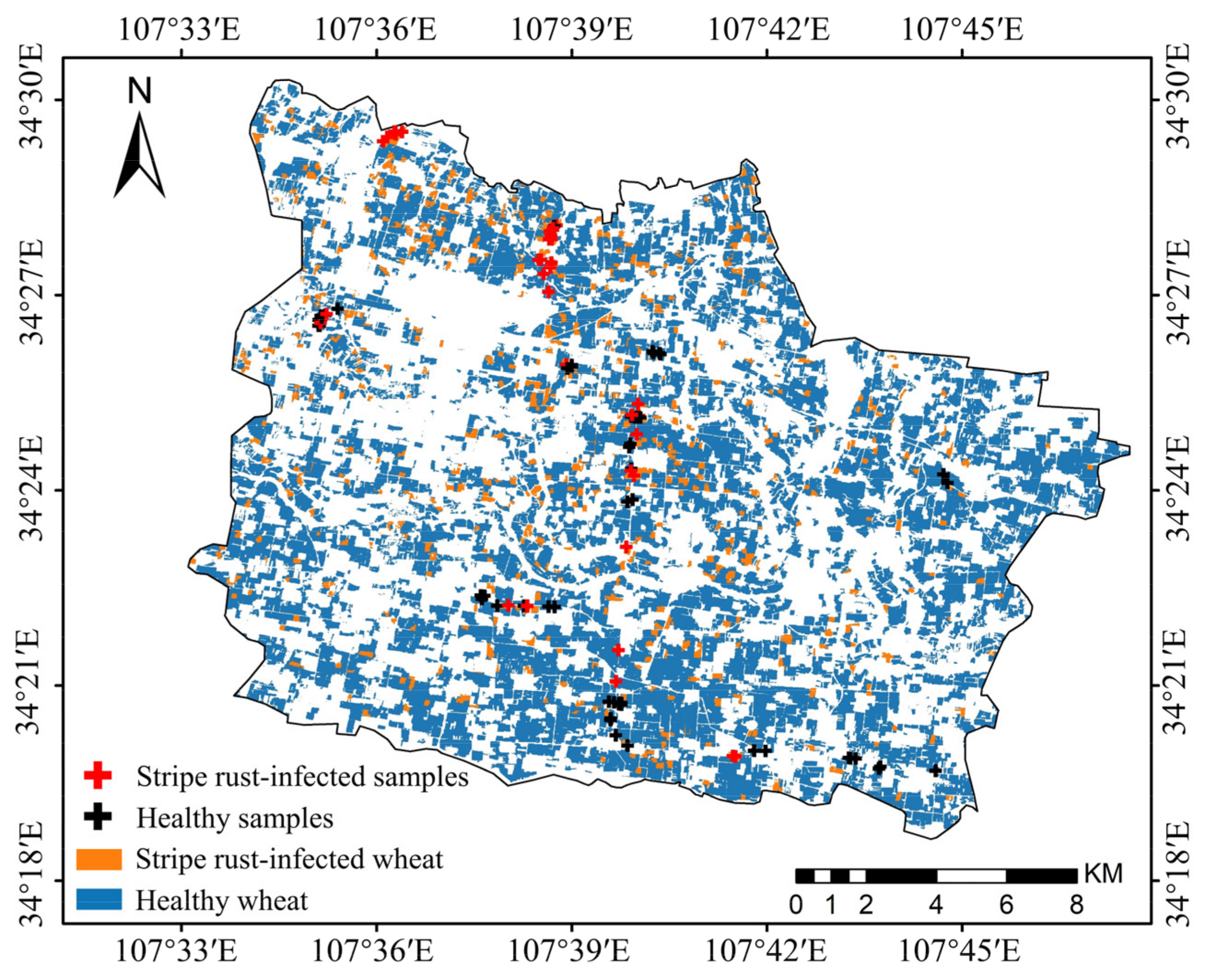
| Vegetation Indices Definition | Formula | Correlation |
|---|---|---|
| Normalized Difference Vegetation Index, NDVI [38] | LAI, biomass | |
| Normalized Difference Vegetation Index red-edge, NDVIre [39] | LAI, biomass | |
| Plant Senescence Reflectance Index, PSRI [40] | Pigment content, Vegetation health | |
| Red-edge Disease Stress Index, REDSI [28] | Sensitive to stripe rust | |
| Triangular Vegetation Index, TVI [41] | Vegetation status | |
| Disease Water Stress Index, DSWI [42] | Water status |
| Feature | Time Window | ||||||
|---|---|---|---|---|---|---|---|
| M12 | M01 | M02 | B07 | B14 | B21 | B28 | |
| ATEM | *** | *** | |||||
| HTEM | *** | ||||||
| LTEM | *** | *** | |||||
| AGST | |||||||
| HGST | *** | ||||||
| LGST | *** | ||||||
| SSD | *** | *** | *** | *** | |||
| PRE | *** | *** | *** | ||||
| RHU | *** | *** | *** | ||||
| Feature | Parameter of RF | Parameter of SVM | |
|---|---|---|---|
| The Number of Trees | C | γ | |
| VIs | 3 | 5.31 | 12.18 |
| PIVIs | 3 | 2.87 | 13.67 |
| VIs + MFs | 5 | 1.58 | 13.91 |
| PIVIs + MFs | 5 | 0.88 | 8.23 |
| Feature | Healthy | Infected | Sum | UA | OA | Kappa | |
|---|---|---|---|---|---|---|---|
| VIs | Healthy | 36 | 13 | 49 | 73.5% | 71.1% | 0.422 |
| Infected | 15 | 33 | 48 | 68.8% | |||
| Sum | 51 | 46 | 97 | ||||
| PA | 70.6% | 71.7% | |||||
| PIVIs | Healthy | 40 | 10 | 50 | 80% | 78.4% | 0.566 |
| Infected | 11 | 36 | 47 | 76.6% | |||
| Sum | 51 | 46 | 97 | ||||
| PA | 78.4% | 78.3% | |||||
| VIs + MFs | Healthy | 41 | 9 | 50 | 82% | 80.4% | 0.608 |
| Infected | 10 | 37 | 47 | 78.7% | |||
| Sum | 51 | 46 | 97 | ||||
| PA | 80.4% | 80.4% | |||||
| PIVIs + MFs | Healthy | 45 | 5 | 50 | 90% | 88.7% | 0.772 |
| Infected | 6 | 41 | 47 | 87.2% | |||
| Sum | 51 | 46 | 97 | ||||
| PA | 88.2% | 89.1% |
| Feature | Healthy | Infected | Sum | UA | OA | Kappa | |
|---|---|---|---|---|---|---|---|
| VIs | Healthy | 34 | 15 | 49 | 69.4% | 67.0% | 0.340 |
| Infected | 17 | 31 | 48 | 64.5% | |||
| Sum | 51 | 46 | 97 | ||||
| PA | 66.7% | 67.4% | |||||
| PIVIs | Healthy | 38 | 12 | 50 | 76% | 74.2% | 0.484 |
| Infected | 13 | 34 | 47 | 72.3% | |||
| Sum | 51 | 46 | 97 | ||||
| PA | 74.5% | 73.9% | |||||
| VIs + MFs | Healthy | 39 | 11 | 50 | 78% | 76.3% | 0.525 |
| Infected | 12 | 35 | 47 | 74.5% | |||
| Sum | 51 | 46 | 97 | ||||
| PA | 76.5% | 76.1% | |||||
| PIVIs + MFs | Healthy | 44 | 7 | 51 | 86.3% | 85.6% | 0.711 |
| Infected | 7 | 39 | 46 | 84.8% | |||
| Sum | 51 | 46 | 97 | ||||
| PA | 86.3% | 84.8% |
| Feature | Healthy | Infected | Sum | UA | OA | Kappa | |
|---|---|---|---|---|---|---|---|
| VIs | Healthy | 32 | 17 | 49 | 65.3% | 62.9% | 0.257 |
| Infected | 19 | 29 | 48 | 60.4% | |||
| Sum | 51 | 46 | 97 | ||||
| PA | 62.7% | 63% | |||||
| PIVIs | Healthy | 36 | 14 | 50 | 72% | 70.1% | 0.401 |
| Infected | 15 | 32 | 47 | 68.1% | |||
| Sum | 51 | 46 | 97 | ||||
| PA | 70.6% | 69.6% | |||||
| VIs + MFs | Healthy | 38 | 12 | 50 | 76% | 74.2% | 0.484 |
| Infected | 13 | 34 | 47 | 72.3% | |||
| Sum | 51 | 46 | 97 | ||||
| PA | 74.5% | 73.9% | |||||
| PIVIs + MFs | Healthy | 42 | 9 | 51 | 82.4% | 81.4% | 0.628 |
| Infected | 9 | 37 | 46 | 80.4% | |||
| Sum | 51 | 46 | 97 | ||||
| PA | 82.4% | 80.4% |
Publisher’s Note: MDPI stays neutral with regard to jurisdictional claims in published maps and institutional affiliations. |
© 2022 by the authors. Licensee MDPI, Basel, Switzerland. This article is an open access article distributed under the terms and conditions of the Creative Commons Attribution (CC BY) license (https://creativecommons.org/licenses/by/4.0/).
Share and Cite
Ruan, C.; Dong, Y.; Huang, W.; Huang, L.; Ye, H.; Ma, H.; Guo, A.; Sun, R. Integrating Remote Sensing and Meteorological Data to Predict Wheat Stripe Rust. Remote Sens. 2022, 14, 1221. https://doi.org/10.3390/rs14051221
Ruan C, Dong Y, Huang W, Huang L, Ye H, Ma H, Guo A, Sun R. Integrating Remote Sensing and Meteorological Data to Predict Wheat Stripe Rust. Remote Sensing. 2022; 14(5):1221. https://doi.org/10.3390/rs14051221
Chicago/Turabian StyleRuan, Chao, Yingying Dong, Wenjiang Huang, Linsheng Huang, Huichun Ye, Huiqin Ma, Anting Guo, and Ruiqi Sun. 2022. "Integrating Remote Sensing and Meteorological Data to Predict Wheat Stripe Rust" Remote Sensing 14, no. 5: 1221. https://doi.org/10.3390/rs14051221
APA StyleRuan, C., Dong, Y., Huang, W., Huang, L., Ye, H., Ma, H., Guo, A., & Sun, R. (2022). Integrating Remote Sensing and Meteorological Data to Predict Wheat Stripe Rust. Remote Sensing, 14(5), 1221. https://doi.org/10.3390/rs14051221








